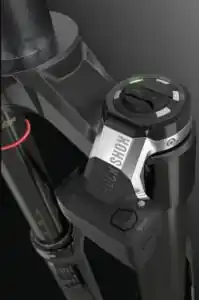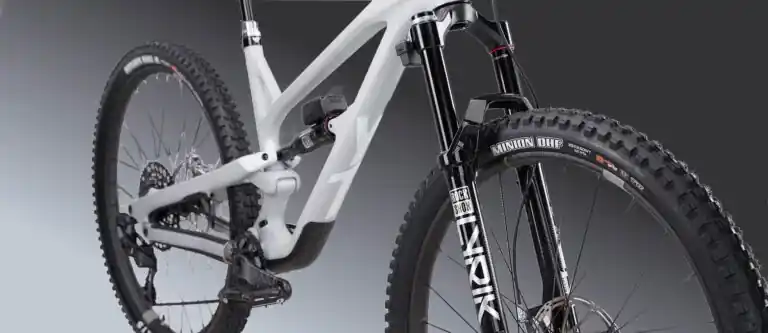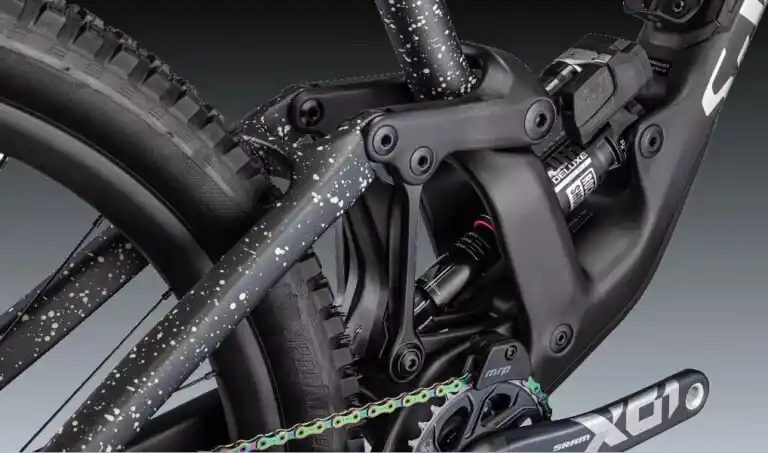RockShox Flight Attendant – Mindblowing A.I. Suspension

Released for the 2022 RockShox range, the automatic suspension adjustment system called Flight Attendant is still streets ahead of any other e-MTB suspension technology. The Flight Attendant is fitted to many top end e-bikes from Trek, Specialized, Canyon, and YT.
- Trek Slash 9.9 XX1 AXS Flight Attendant
- Specialized S-Works Enduro
- Canyon Spectral 29 CF LTD AXS
- Canyon Neuron CF SLX LTD
- YT Jeffsy Uncaged 6
Smart tech inside the Flight Attendant system automatically regulates the forks (and shock) by adjusting the suspension between Open, Lock, or Pedal.
Adjusting to changing track conditions in real time, Flight Attendant provides the most efficient ride possible.
Flight Attendant is completely wireless, with Bluetooth enabled sensors transmitting data every five milliseconds. Predictive algorithms at the core of the Flight Attendant intelligently adjust suspension for the track ahead.

How does Flight Attendant work?

The rider first sets rebound, damping and spring compression as normal, with the Flight Attendant switched off.
Accelerometers inside the fork and shock modules, with gradient and pedal sensors in the crankset, collect information from the rider, and deliver data on track conditions.
The CPU receives the information detected by the sensors monitoring rider effort, tilt angles, and track conditions. A CPU at the core of the RockShox Flight Attendant then uses sophisticated algorithms to calculate the best settings for track conditions.

The CPU controls motor modules on the shock and forks to vary damping between open and lock. Compression damping is adjusted using geared motors to push a needle in and out of a valve. The needle can progressively close the valve and lock the suspension if required.
Every five milliseconds, the algorithm predicts terrain and rider input. Adjusting the suspension, the RockShox Flight Attendant system continuously selects the best option for the track.
Flight Attendant increases the effectiveness of your suspension by constantly locking or opening the suspension to suit changing track conditions.
The suspension will stiffen when traveling on smooth surfaces to minimize squat. This reduces energy sapping suspension bounce to increase pedaling efficiency.
Similarly, the suspension will open when the sensors detect downhill slopes, or encounter bumps. When traversing jittery tracks, suspension is adjusted to optimize grip when the rider needs it most.
The rider first sets rebound, damping and spring compression as normal, with the Flight Attendant switched off.
Accelerometers inside the fork and shock modules, with gradient and pedal sensors in the crankset, collect information from the rider, and deliver data on track conditions.
The CPU receives the information detected by the sensors monitoring rider effort, tilt angles, and track conditions. A CPU at the core of the RockShox Flight Attendant then uses sophisticated algorithms to calculate the best settings for track conditions.
The CPU controls motor modules on the shock and forks to vary damping between open and lock. Compression damping is adjusted using geared motors to push a needle in and out of a valve. The needle can progressively close the valve and lock the suspension if required.
Flight Attendant allows the rider to extract every inch of suspension travel for optimal comfort when conditions are rough.
The Flight Attendant system reacts almost instantly to changing track conditions. The processor algorithm uses simple Artificial Intelligence to predict the track ahead.
Motors open or close ports within the compression assembly as the sophisticated algorithm adjusts damping. Suspension can be gradually restricted, or completely locked, depending on the needle position.
FLIGHT ATTENDANT SETTINGS

1. Setup
The rider sets the fork sag, spring pressures and rebound damping, just as you would on any full-suspension bike. Next, you pair the three Flight Attendant components (fork control module, pedal sensor and shock motor module).
Once spring you set compression, rebound, and damping, calibrating the Flight Attendant takes a couple of minutes. Calibrating the Flight Attendant is a once only task. There is an easy to follow video tutorial on RockShox website which completes calibration for life.
2. Handlebar Controller
There are three options on the optional handlebar control auto, manual, and override.
Auto mode switches between Open, Closed or Neutral positions automatically. This setting allows the predictive algorithm to choose the best damping settings.
Manual mode lets the rider choose settings by pressing one of the three options on the AXS controller positioned on the handlebars.
Pressing and holding the override on the controller switches from ‘Auto’ mode to a preset option. Pressing the button again resets the system to Auto.
3. Why Have An Override?
It seems odd that there is an override option. After all, wouldn’t you be tossing away your hard earned samolians if you don’t use the system? The reason for the override is that there are often situations where you simply don’t care about optimal settings.
Picture this. You are neck and neck in a sprint for the finish line, and the section is chattery. Flight Attendant would soften the suspension, but the last thing you want is energy sapping bounce.

Flight attendant for e-bikes
Flight Attendant is available on 5 MTB models and is also available for after market purchase.
RockShox advises that their Flight Attendant is approved for use on both regular mountain bikes and e-MTBs. The system is being fitted to more top-end electric mountain bikes as we roll deeper into 2024.
Tantalizingly, the RockShox website shows a video of the product being fitted to an e-MTB.

Fitting the System
Flight Attendant is wireless, with the system comprising three units plus an optional override switch. The override switch fits to the left side of the handlebars to give the rider more control over system behavior.
The most visible component of the system is the control module that sits on top of the fork which sports the system controls.
The wireless system requires no cable porting to hide ugly connector wires. RockShox design is fantastic, neatly integrating the compact, rechargeable batteries into the fork and shock modules. There is no bulky central power source or controller. This makes fitting neat, straightforward, and convenient.
The shock module adds a little bulk to the shock size, with the battery sitting at the back to protect the unit from crash damage. Although the system is compact, some frames may not have clearance for a Flight Attendant-equipped shock. Flight Attendant is offered on RockShox ZEB, Lyrik, and Pike forks.
As stated above, Flight Attendant is currently provided only on bike packages from a few manufacturers. We expect DIY suspension upgrades will be available for individual purchase by mid 2022.
The batteries are the same AXS units found in other SRAM products. This means that they are cross-compatible. RockShox claim batteries provide 20-30 hours use on the fork, and 30-40 hours for the rear shock.
The AAA battery used in the pedal sensor is rated for 200 hours before requiring replacement. The optional handlebar control unit operates both Flight Attendant and ASX dropper post. Fitted to the left side of the bars, the handlebar unit uses a CR2032 battery, which will provide 200 hours of operation.

Performance
I expected the Flight Attendant to be just another option to dial in on the suspension, but it proved to be very distinctive. The system is smooth, but very obvious. Just like other suspension settings, once you have found the sweet spot for the track, the system does the rest.
On smoother sections, it continuously reminded me that the Flight Attendant was working. The servos are continuously whirring as the predictive algorithm kicks them into action.
The sound is a little bizarre at first, and more noticeable when the trail is passive. You don’t notice the noise when the trail becomes more dramatic, as focus shifts to keeping the bike pointed in the right direction.
Flight Attendant noticeably tightens the shock, especially on uphill sections. The system stiffens (or locks) the shock frequently on smooth sections to give a stiffer, more efficient ride. You are also aware of the servos constantly adjusting the forks, although the effect is less dramatic at the front.
When pointing downhill, the system frees the suspension, giving full movement to soak up the worst bumps and drops.

Three modes of operation
I felt the difference as the system worked its magic in the background. I switched the Flight Attendant between Auto, Pedal and Open, while riding similar sections of track. Switching the system between option really brings home how effective the Flight Attendant is.
The three modes of Open, Auto, and Pedal are tuned for the type of trail you want to ride.
The Open setting has the least input from the Flight Attendant. This setting essentially tells the system to prepare to tackle rough tracks. The system expects rocks and jumps, so the suspension remains more open in anticipation of rock hopping.
Setting the system to Pedal has the opposite effect, with damping tightening the harder, and more frequently. This setting signals the system to expect a cross-country track.
Setting the system to Auto and the Flight Attendant goes through its motions. Auto felt the most effective for me on the Enduro tracks I like to ride.
CONCLUSION
There are a few downsides with Flight Attendant adding weight, complexity, and cost. However, for enthusiasts that love innovative technology, this is a seriously impressive system.
The Flight Attendant shines when riding quickly on varying, complex, single track. The system can automatically stiffen, or lockout, the suspension on sections where the rider wouldn’t have time to reach for a manual lockout lever.
The system remains open as much as possible, only switching to a stronger setting when the algorithm considers it essential.
If you want to get the most from your ride, Flight Attendant is a must.
